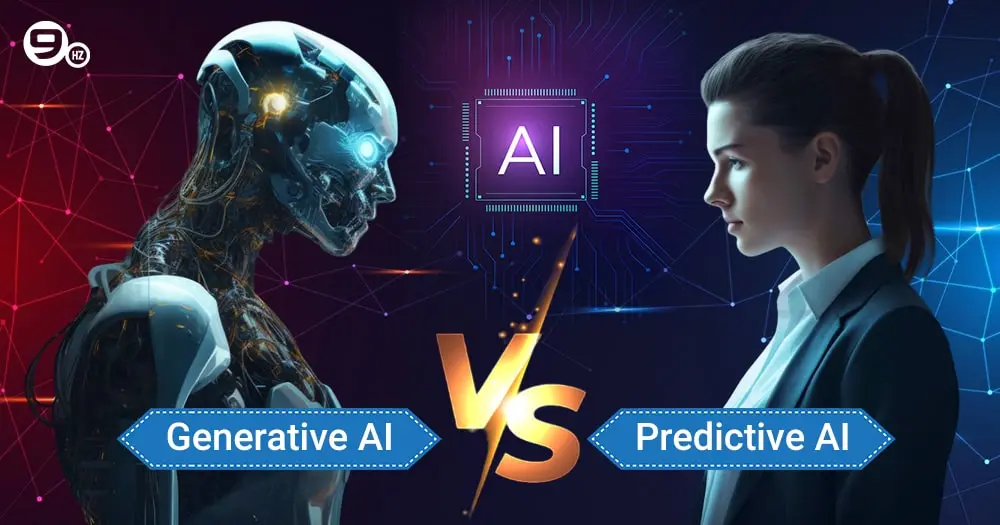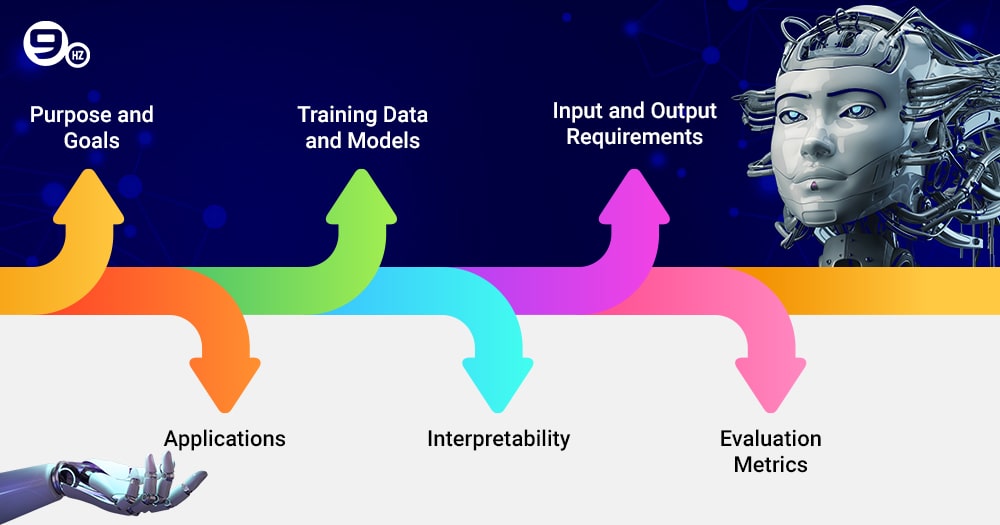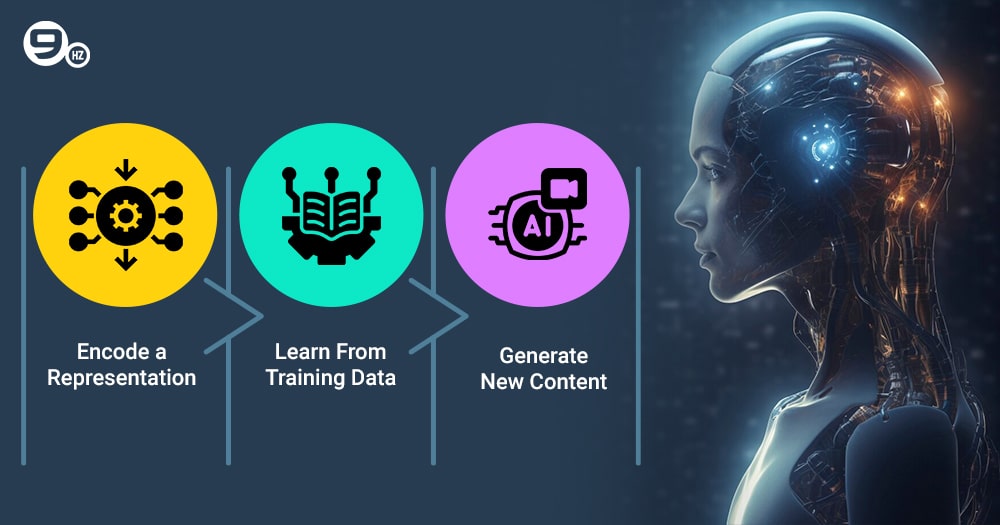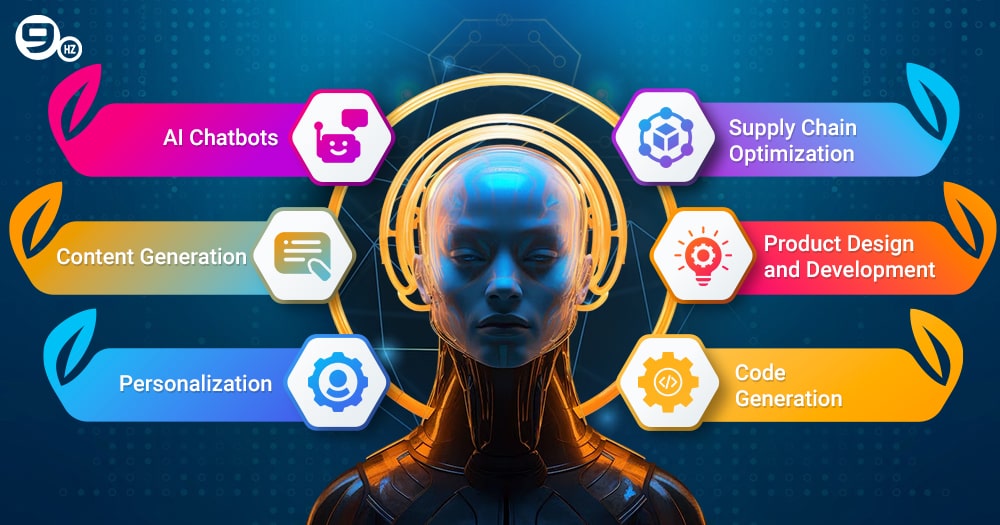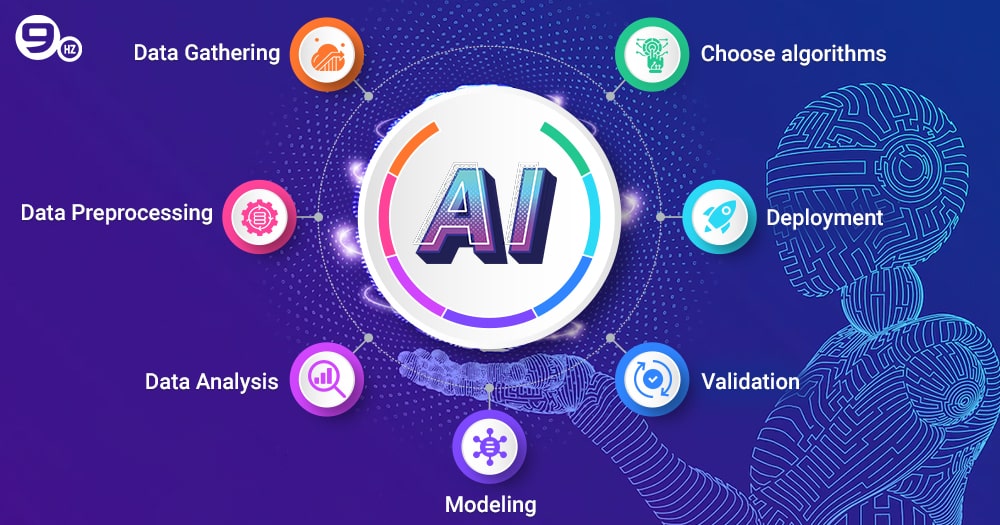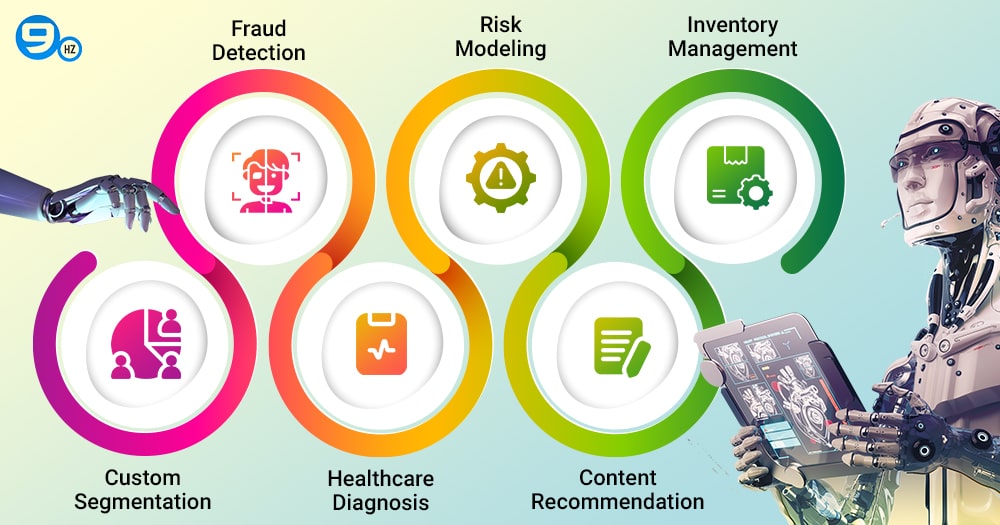Generative AI vs Predictive AI. These two types of AI have the potential to bring technology into reality. Where Generative AI is used to generate creative content such as text, images, audio, videos, and codes based on existing data. On the other hand, Predictive AI uses large amounts of data to analyze it and come up with predictions and future outcomes.
When it comes to artificial general intelligence, every sector, from healthcare and finance to creative fields, has been positively impacted by it. According to the statistics, the AI market is expected to reach $299.64 billion by 2026 with an expected CAGR of 38.1% between 2022 to 2030. It clearly shows that AI is transforming industries in various ways.
So, if you’re interested to know more about what is generative ai vs predictive ai then keep reading. In this article, we will cover everything about difference between generative and predictive ai, how they work, pros and cons, and best use cases.
Differences Between Generative AI and Predictive AI
Let’s dive into the key differences between Generative AI vs Predictive AI
| Parameter | Generative AI | Predictive AI |
|---|---|---|
| Primary function | The main purpose of using Generative AI is to create new information or content | The main purpose of using Predictive AI is to analyze the historical context and make predictions about future outcomes |
| Training data | It requires diverse and comprehensive data | It requires historical data for learning, analyzing, and making future predictions |
| Algorithms | It uses algorithms like GANs, VAEs, and Transformer models | It uses algorithms like decision trees, random forests, and neural networks |
| Learning process | It learns patterns and relationships in data to generate relevant and new content | It learns from historical data, identifies patterns, and makes future predictions |
| Challenges | It lacks authenticity and specificity in generated output | It’s limited to existing patterns and sometimes misses novel scenarios |
| Creativity | It helps to enhance creativity to another level by generating new creative content | It is not capable of generating creative content |
| Training complexity | It required more complex and resource-intensive data as input to capture variations and patterns and generate high-quality output | It required less complex training and the use of historical data to make future outcomes |
| Use Cases | It is used to produce new, original, and creative content like text, images, audio, video, and codes | It is used for business analytics and financial forecasting to analyze historical data and make future predictions and outcomes |
| Impact | It drives new innovations and creativity in the real world | It enhances strategies, planning, and data-driven decisions |
| Evaluation | Generative AI output is evaluated based on the authenticity and creativity of the generated content | Predictive AI output is evaluated based on accuracy, relevance, and precision |
| Examples | Some of the best examples of generative AI tools are DALL-E 2 for image generation, ChatGPT-4 for text generation, Synthesia, Murf for audio/video, and AlphaCode for coding | Some of the best examples of predictive analysis tools are Amazon Forecast, Adobe Analytics, Microsoft Azure, IBM Watson Studio, etc |
| Industries | Art, Entertainment and Design | Healthcare, Finance and Retail |
This table highlights the fundamental differences between Generative AI and Predictive AI in terms of their primary function, training data, algorithms, learning process, challenges, creativity, training complexity, etc.
Generative AI vs Predictive AI: 6 Key Differences Explained
1. Purpose and Goals
The main purpose of using Generative AI is to generate creative content. Such as text, images, audio/videos and codes. On the other hand, the purpose of predictive AI is to analyze the historical data and make predictions about future events. So that businesses can make informed decisions and get potential outcomes.
2. Training Data and Models
Generative AI uses many methods, such as neural networks, generative adversarial networks, and machine learning, to learn from given data and generate creative outputs. Predictive AI uses statistical algorithms and ML models to deeply analyze historical data, identify patterns, and come up with future predictions and outcomes.
3. Input and Output Requirements
Generative AI requires initial input like a command, seed, or example to start processing the data as input and generate creative content as output. On the other hand, Predictive AI completely relies on historical data as input to process, analyze, and make future predictions.
4. Applications
Generative AI can be used for different domains. Such as content creation, drug discovery, and designing new content with specific characteristics. Predictive AI has demand across various industries, including finance, the stock market, healthcare and marketing.
5. Interpretability
Generative AI creates new creative content based on analyzing input data. But the output accountability can be an issue because humans want transparency and accountability. On the other hand, Predictive AI has some accountability because it generates output based on the historical data it analyzes and the output also shows the relationship with given input to ensure that predictive data comes from input.
6. Evaluation Metrics
Generative AI models are evaluated based on the quality and authenticity of the content. On the other hand, Predictive AI models are evaluated based on the accuracy and relevancy of their predictions.
What is Generative AI?
Generative AI is also known as Generative Artificial Intelligence. It is a type of AI that uses machine learning models to analyze the given data. It can identify patterns and structures, and generate original content in different formats. Such as text, audio, video, images, and code. The quality of newly generated content depends on the quality of data given at input and how well it matches with the use case.
Generative AI is not a concept anymore. It is a reality in today’s world and the world has started utilizing the potential of Generative AI. Some of the most popular Generative AI tools are ChatGPT04, Dalle-2, Synthesia and many others who are now generating human-like original content in different media formats.
Whenever any data as input is given to the Generative AI, it uses generative adversarial networks, variational autoencoders, and autoregressive models to learn patterns and structure from the input to understand and generate a content output.
Nowadays, it is a most effective and helpful tool for content creators, designers, and content marketers to enhance their creativity levels and generate the most unique and original content.
When discussing Generative AI vs Predictive AI, it’s important to note that Generative AI focuses on creating new content, whereas Predictive AI analyzes historical data to make future predictions. Both types of AI are transforming industries, but they serve distinct purposes.
How Do Generative AI Models Work?
Generative AI Models are the most advanced models. They are capable of classifying the data, learning data patterns and using it to generate entirely new original data. There are various types of content the Generative AI models can generate such as text, images, audio/videos and codes.
If you have used any Generative AI tool like ChatGPT then it is much easier to use it. You just need to give some set of instructions and it will understand your instructions and generate human like text content as per your input. But many people are unaware of the behind process of generative AI models.
Generative AI uses various models to learn from the input data and generate new content. Some most popular models are generative adversarial networks, variational autoencoders, diffusion models, transformer networks and reinforcement learning. These models together work and power Generative AI to generate high-quality, unique and optimized content in different domains.
Here are the three steps process for an easy understanding of how Generative AI models work:
1. Encode a Representation: Generative AI models first start encoding what type of content needs to generate. Whether it’s text, image, audio, video or code. Then based on the input requirement, generative AI uses the models to process the data.
2. Learn From Training Data: Now, models start analyzing the given input and identify patterns and structure from given data to understand the requirement.
3. Generate New Content: Then, the models start generating new human-like unique content as an output.
Advantages and Disadvantages of Generative AI
| Advantages | Disadvantages |
|---|---|
| It generated high-quality creative content in different formats | AI-generated content quality and consistency can vary |
| It streamlines efficiency and provides budget-friendly solutions | It has complete data dependency to generate a new response |
| It allows creators to enhance their creativity and possibilities with AI | It can be used to generate false or misleading content |
| It gives personalized content that is tailored as per given input | Sometimes, it may lack the human touch during content generation |
| It reduces human efforts sav, saves time for repetitive and lower-end tasks, and lets them focus on innovations |
Six Most Common Generative AI Use Cases
When generative AI comes into reality then, most people think it will replace the jobs of many, but it makes the work much easier for them and takes creativity to the next level. Here are some of the most common generative AI use cases:
1. AI Chatbots
Generative AI-powered chatbots are catching huge attention because they are conversational and able to understand users’ feedback and respond accordingly. Most businesses are using AI chatbots to streamline their customer support system, automate repetitive tasks, and enhance customer satisfaction, which overall leads to business growth. These AI chatbots have numerous models that analyze conversations with users, identify patterns, and improve their responses for better outcomes.
2. Content Generation
Generative AI is heavily used for content generation in different formats. These models are capable of analyzing the data, identifying patterns and generating high-quality original content in different formats such as ultra realistic images, videos, text, audios in just one tap. Some of the most popular generative AI tools are ChatGPT, DALL-E 2, Midjourney etc. Users just need to give some set of instructions or prompt, let the generative AI tool analyze the data and come up with the most relevant outcome.
3. Personalization
Another popular use of generative AI can be seen in providing personalized user experiences. These generative AI models are capable of understanding users’ data. They learn from their behavior, identifying patterns, and coming up with personalized content and recommendations that can help businesses connect with their customers personally. One such great example is Netflix. They use generative AI to understand users interests, behavior, and preferences. And generate more accurate recommendations of the shows and movies that users love to watch and spend more time on their platform.
4. Supply Chain Optimization
Generative AI models can assess the supply chain operations in different scenarios, identify patterns and structure and come up with some best routes for supply chain optimization and streamline the operations more efficiently.
5. Product Design and Development
Generative AI models are also utilized in product design and development, where these models learn from given data, identify patterns and generate new unique designs based on previous patterns and designs.
6. Code Generation
Many coders are now utilsing the power of generative AI. These generative AI models are capable of real time coding, streamline development processes and enhance productivity. Companies like microsoft power apps development company are at the forefront of leveraging generative AI to empower developers with tools that automate repetitive tasks, suggest code optimizations, and accelerate the software development lifecycle.
What is Predictive AI?
Predictive AI is also known as predictive analytics; it’s a type of AI that is used to analyze historical data, identify insightful patterns, and make predictions about future outcomes, trends, and events.
Generative AI vs Predictive AI highlights that while Predictive AI focuses on analyzing and forecasting based on existing data, Generative AI is designed to create new content.
Predictive AI uses statistical algorithms and machine learning techniques to combine work on analyzing historical and current data to come up with accurate predictions.
These insightful predictions help businesses to make data driven decisions in a wide range of domains. It’s widely used in major industries like finance, marketing, healthcare, retail, etc.
How Do Predictive AI Models Work?
Predictive AI uses machine learning algorithms to analyze historical data. It identifies patterns and connections, and uses these insights to make future predictions and outcomes. It has various components that are used in predictive AI to make the operations work. Here are some key components of predictive AI:
- Data Gathering: It collects relevant historical data from different sources
- Data preprocessing: It cleans the data by managing their missing values, irrelevant variables for outliers
- Choose algorithms: Now, it chooses the best-fit algorithm based on the data type for making accurate and relevant predictions
- Data Analysis: Using machine learning techniques and models together to analyze the data
- Modeling: It develops algorithms that can specifically detect data patterns and relationships between them
- Validation: Now, it tests the models with a subset of data to ensure data accuracy
- Deployment: Implement the model for future predictions and outcomes
Most businesses are now using the predictive AI models to make future predictions and enhance personalized user experience that overall leads to business growth.
Advantages and Disadvantages of Predictive AI
| Advantages | Disadvantages |
|---|---|
| It helps to make unbiased and data-driven decisions | It lacks emotion and creativity |
| It helps to predict future outcomes and trends | It doesn’t improve their operations with experience |
| It reduces human errors and increase prediction accuracy | Its output totally depends on the quality of data |
| It can automate many repetitive tasks | It has data privacy concern |
| It saves time, efforts and money |
Six Most Common Predictive AI Use Cases
Predictive AI is revolutionizing various industries and helping businesses to make data driven decisions. Here are some of the most common use cases of predictive AI:
1. Fraud Detection
Predictive AI has some advanced algorithms which can be used for fraud detection. It can analyze financial transactions and identify patterns and user behavior to quickly spot if there are any suspicious activities. It is used by companies and financial institutions to ensure security.
2. Risk Modeling
Predictive AI models are capable of analyzing historical and current data to assess if there’s any potential risk in any scenarios in business. It helps businesses to make data-driven decisions and find a solution for reducing the risks.
3. Inventory Management
In the ecommerce industry, predictive AI is helping retailers optimize their inventory by analyzing previous sales data, market trends, and operations. After analysis, it will provide the most optimal way to manage inventory, reduce unnecessary inventory, save costs, and streamline operations.
4. Custom Segmentation
Businesses can also use predictive AI for customer segmentation. With advanced analytics models, it can analyze customers’ details, behavior, preferences, and interests. And based on these data, Predictive AI is able to come up with marketing strategies for specific groups of customers. That overall helps businesses to build engagement with customers and drive more results.
5. Healthcare Diagnosis
One of the significant impacts made by predictive AI is in the healthcare sector. Where the predictive AI models are able to analyze patient health details, symptoms, medical history and come up with most accurate diagnoses suggestions. When healthcare organizations are using predictive AI, there’s better improvement in decision-making, better patient care and outcomes.
6. Content recommendation
Predictive AI is also useful for marketing purposes where it can analyze the potential audience, behavior, interaction with online content and after analysis provide personalized content recommendation that help businesses to nurture their customers more efficiently and increase customers satisfaction.
Conclusion: Generative AI vs Predictive AI
Generative AI and Predictive AI are the two most widely used technologies in various domains. Both come with their functionalities and different use cases. By understanding the difference between generative AI and predictive AI, organizations can use their potential and focus on growth and scalability. In almost every sector, from healthcare, marketing, finance, and retail, the usage of AI is growing, and businesses are utilizing its potential to get maximum results. A generative AI development company can help bring new creativity into reality, and predictive AI gives future predictions for making data-driven decisions. We hope this guide helps you know everything about both generative AI vs predictive AI, how it works, and its uses.
FAQ’s: Generative AI and Predictive AI
Q.1 What is Predictive AI vs Generative AI vs Machine Learning?
Predictive AI is a type of AI which analyzes historical data and comes up with future predictions and outcomes. On the other hand, Generative AI is another type of AI which can take data as input and use it to generate unique content in different formats. Machine learning is a subset of AI which enables predictive AI to make data-driven decisions based on existing data.
Q.2 Is Alexa a Generative AI?
Yes, Amazon Alexa is a generative AI which supports voice assistants to perform tasks. The use of generative AI in Alexa enhances the user experience and gives more personalized responses.
Q.3 Is ChatGPT Generative AI or Predictive AI?
ChatGPT is a form of Generative AI which has advanced models to analyze users input data and come up with unique pieces of content as per given prompt.
Q.4 What is the Most Famous Generative AI?
DALL-E 2 is one of the most popular generative AI models which is capable of converting text into ultra realistic images.
Q.5 What is an Example of a Predictive Algorithm?
Some examples of a predictive algorithm are clustering model, forecast model, neural networks, decision tree algorithms and time series model.
Great Together!
